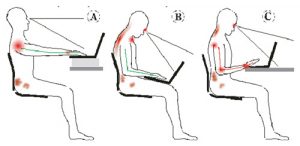

In standard chair sitting there is NO COMFORTABLE POSITION that doesn’t create inflammation, joint stress, and repetitive use injury. Pressure points/ Inflammation shown in red.
Back pain is epidemic in America. It costs us over $4 billion each year and, aside from the common cold, keeps more people away from work than any other single cause. Diverse evidence from many cultures shows that sitting has been associated with numerous problems: back pain of all sorts, fatigue, varicose veins, stress, and problems with the diaphragm, circulation, digestion, elimination, and general body development. Ergonomic researchers believe if they could only invent the perfect chair, all this would be solved.
Dr. Galen Cranz’s, revolutionary book The Chair: Rethinking Culture, Body and Design offers another hypothesis.
After extensive research, she has reached the conclusion that no amount of ergonomic tinkering can correct the classic right-angle seated posture which is intrinsic in chairs. The problem with chairs, according to Cranz and other radical ‘somatic’ practitioners who practice ‘new ergonomics,’ is that we have been forced into a ‘table and chair’ culture, where many activities take place in a right-angled seated position. This position forces the body into a C-shaped slump and this places uneven pressure on the vertebral disks of the lower back. With time, the spine can become deformed and erode disks.
Dr. Cranz proposes all this effort could be better directed toward inventing an entirely new system to promote movement at work and at schools.

Native American girl in tipi with willow reed backrest.
When a person leans into the chair back, there is both a backward and a downward force. The downward force pushes the bottom of the pelvis forward. Eventually, the sitter finds himself sitting on his tailbone at the edge of the chair with the spine as a whole transformed into a C-shaped slouch. Of course the next step is to pick oneself up and lean back into the chair again. This only starts the whole process over again. ‘Sitting up straight’ has to be forced, and is probably worse than the slouch.
People in third world countries do not use chairs but sit on the ground or floor instead. These peoples have retained the ability to sit upright without back support–otherwise known as ‘autonomous’ or ‘active’ sitting. And history shows us evidence of autonomous sitting. Jesus’ last supper was actually not held at a table but in the typical Roman fashion of reclining in a U-shaped ‘triclinia.’ The host and guests ate while lying on their sides, propped up by a pillow. The term “sitting Indian style” comes from Native Americans who honor the earth by sitting on her. And the Buddha attained his enlightenment by just sitting (perhaps meditating) for several days with absolutely no back support.
So why is it so hard? Have you ever tried just sitting on the floor or ground? You must have noticed the body tends to fall down towards the back. You must have noticed that tremendous effort is needed to pull oneself forward to keep this from happening. A lifetime of using chairs and back support is all the difference. We are locked into a bad habit that saps energy, circulation, and strength. And on top of that, standard exercises can actually exacerbate the situation. The internal muscles of the pelvis and torso are toned only by using them in natural ways–e.g. active sitting, standing, walking, etc. Many callisthenic exercises such as sit-ups can create imbalance because all the muscles are not strengthened and toned evenly. In fact, the internal muscles may not be reached at all.

The Zen Office™ offers an alternative to Chair Sitting
The answer lies in re-educating the body to move the way it was designed. Simply by using the body properly, the muscles are toned and ‘autonomous’ or ‘active’ sitting can be regained. In America many people are now trying active sitting for meditation. It has long been known that active sitting can enhance the meditation experience. It does this by freeing circulation and breathing, which in turn helps induce relaxation. Back pain can hamper or even prevent one from meditation practice. People beginning meditation often encounter one or all of these challenges:
1) Being new to the ‘sport’, internal torso and pelvic muscles are atrophied and cannot support the body very long.
2) With meditation comes body awareness. A lot of people notice back pain where it might have been before but they hadn’t noticed it.
3) Improper ‘use’ of the body, or simply not having knowledge of good sitting technique, can cause worsening of a problem.
4) Sitting improperly with back support all day does not give the body much opportunity to learn new patterns.
5) A back that is out of alignment will be noticed once one starts sitting this way. Intervention such as chiropractic or rolfing may be necessary.

A “lumbar interbody fusion,” an operation in which the surgeon builds a metal cage around the spine. Very common injury and treatment which is easily avoided.
Since the human body is designed for movement, it doesn’t fit in well with the many hours of sitting required for the average American lifestyle. Most back pain is caused by the repetitive activity of sitting. We sit at home, in the car, at work or school, in the movies, with bodies bent into a right-angled position.
When people begin to meditate on a zafu or kneeling bench they are often completely unprepared. Five or ten minutes can be difficult. Also, it can seem uncomfortable and the meditation can become a struggle just to keep upright. Yet, if we don’t make the transition to active sitting, we will be forever victims of the common chair, prone to medically untreatable and mysterious back pain, injuries and spinal deformities.
The Alexander Technique is a remedy for the problems caused by improper use of the body. Today the Alexander Technique is especially used in dancing, acting, and sports for coordination and efficiency of movement. However it is useful to all of us for re-educating the body about natural movement which doesn’t strain the back and neck– simple every day activities like bending, reaching, walking and sitting. The A.T. involves ‘lessons’ where the teacher helps reeducate the body/mind into ‘good use.’ The backbone (pardon the expression) of the Alexander Technique is how the head, neck and torso are used. More specifically, that the head should be held in such a way (forward and up) that the length of the spine and neck are not shortened or curved. This goes for any activity whether sitting, speaking, or reaching.

Sitting Easy Pose which is similar to cross legged position only the knees are in the air and this doesn’t take as much flexibility as actual cross-legged sitting.
According to Dr. Galen Cranz in The Chair, even ergonomics only perpetuates the problems and misconceptions of sitting. “Ergonomics researchers assume, like most of us, that right-angle sitting is rational, that we need back support, and that we all value comfort. These assumptions get them into trouble–spawning contradictory concepts, invalid research methods, and conflicting recommendations.”
The controversy perhaps begins with the fact that there is no universally accepted operational definition of ‘comfort’. In fact, there are two conflicting points of view. The traditional ergonomic researchers believe comfort is achieved when no muscles are working. Practitioners of the New Ergonomics (including A.T. practitioners) believe comfort happens when an equal amount of work is performed by complimentary muscle groups, also referred to as ‘tonus’.
The ‘no-work’ school is responsible for chairs that ‘cradle’ the body or otherwise force the spine into a C shaped slump. The ‘Tonus’ school hold the radical view that back support is not necessary at all. However, in order for this to work, the legs should be at an angle of 135 degrees to the spine. This keeps the pelvis and therefore the spine in a similar position as walking. At this angle the work of sitting upright is distributed between the front and back of the spine and along its length most evenly. In the early 1970’s Peter Opsvik created the Norwegian Balans Chair™ in response to this knowledge. It is the first chair which allows the 135 degree leg angle in the West. This chair and cheap variations are now seen in offices throughout America, mostly used for computer work. Heeding the call, there have since been some other backless chairs introduced, such as the Bambach Saddle Seat™ and the Shaker style Tilt Seat™ by Carolina Morning Designs. The Tilt Seat™ has the advantage of no pressure on the knees, the ability to shift positions, and to get up and down easily. A similar effect can be accomplished by placing a zafu on a standard flat surfaced wooden chair or stool.

STAND UP DESK using the Tilt Seat™ as laptop stand and Peace Bench™ as keyboard stand. Notice the reverse angle on the Peace Bench™ so wrists are at ease.
Asians have had a completely different approach to sitting and furniture. For centuries Orientals have designed homes and work spaces around floor furniture. We mostly think of Japan and their tatami mats and corresponding futons which get rolled up by day and tucked in closets. You may have seen Japanese sitting neatly in rows like we sit in auditoriums, only they are flat out kneeling on their knees and legs. They also use other furniture or sitting devices called zafus and zabutons. Zafu (za’foo) translates to ‘sewn seat’ and is an oval shaped cushion placed on a zabuton. Zabuton (za’boo tan) translated to ‘sitting mat’ (futon is ‘sleeping mat’). When using a zafu and zabuton, one achieves the desired 135 degree leg-to-spine sitting angle. Also, this is the best position to allow ease of movement, either to get up or to change the angle or direction slightly. The ‘seiza’ or kneeling bench also allows the 135 degree leg-to-spine angle only without the need to cross the legs. Today in America many people who have been introduced to these ‘devices’ or ‘furniture’ for meditation are finding them completely suitable for other purposes. We received an e-mail by someone who was fed up with his ‘table and chair’ lifestyle that was hurting his back. He wanted advice on creating a computer work station on the floor. “Respond quickly,” he wrote, “I am sharpening my saw to cut the legs off of my desk.”
The New Ergonomics calls for a complete rethinking of the way we design and use furniture. The aim is to incorporate movement and wise use of the body into every activity. Here are some principles and guidelines:
1) Practice sitting without back support. This will necessitate a forward sloping seat of some kind. Start a few minutes a day and increase gradually.
2) Start replacing furniture in the house using principles of the New Ergonomics. Planar surfaces instead of contoured, firm instead of overstuffed, a variety of chairs and benches to accommodate different sizes, places to lie down.
3) Whenever you are tired and begin to slump, lay down a few minutes to regain energy. Prop your feet up if possible.
4) Replace sitting with other positions whenever possible. Reclining is one of the best positions for reading or talking on the phone. Also, squatting, standing, and crawling are other alternatives. Walking is often a great way to have a meeting or think through an idea.
5) Incorporate movement into your sitting. Take a break at least once an hour. Stretch, walk, stand up, jump on a mini-trampoline, hang from a bar or do some pull ups, or change positions as often as possible. Instead of sitting for long stretches, break it up with other activities.
6) Convert regular chairs by placing a zafu in the seat to offer an incline.
7) Use a slanted writing or reading surface such as a drafting table to prevent tilting of the head and neck. The desk will need to be taller than a standard desk, because the seat is taller.
Resources
The Chair: Rethinking Culture, Body and Design, by Galen Cranz, W.W. Norton and Co., 1998
This web site has a wealth of information relating to the fields of ergonomics and the Alexander Technique. Invaluable resource!
http://www.acmandal.com/
The official website of New Ergonomics pioneer A.C. Mandal. This gives a concise and well illustrated overview of the concepts of natural sitting
http://humanics-es.com/rethinkingsitting.htm#chairs
This website offers a sobering second opinion on “ergonomic” chairs.
The Complete Guide to the Alexander Technique
http://www.beyondtheofficedoor.com/articles-ergonomic-factors-for-your-office.html
This site has multiple resources for diverse aspects of setting up ergonomic work stations.
The Alexander Technique helps a person with back pain to recognize and prevent harmful patterns and learn to move in harmony with the body’s design.
http://www.egoscue.com/Here is a powerful but simple process for relieving hip pain
![]()
![]()
![]()
